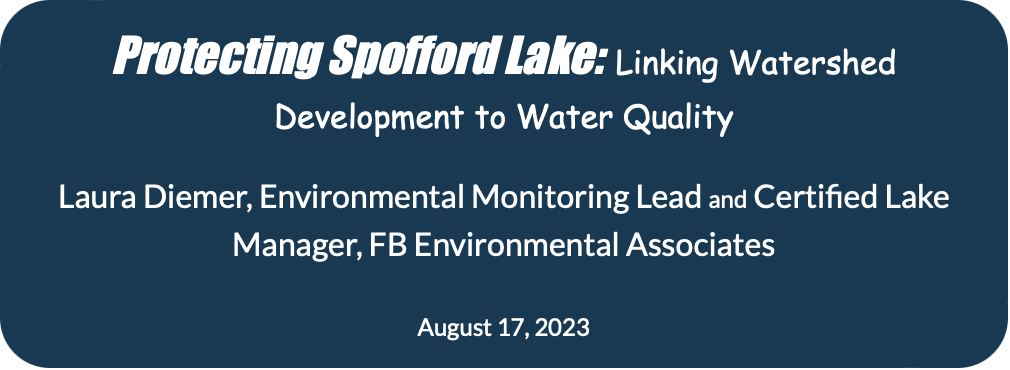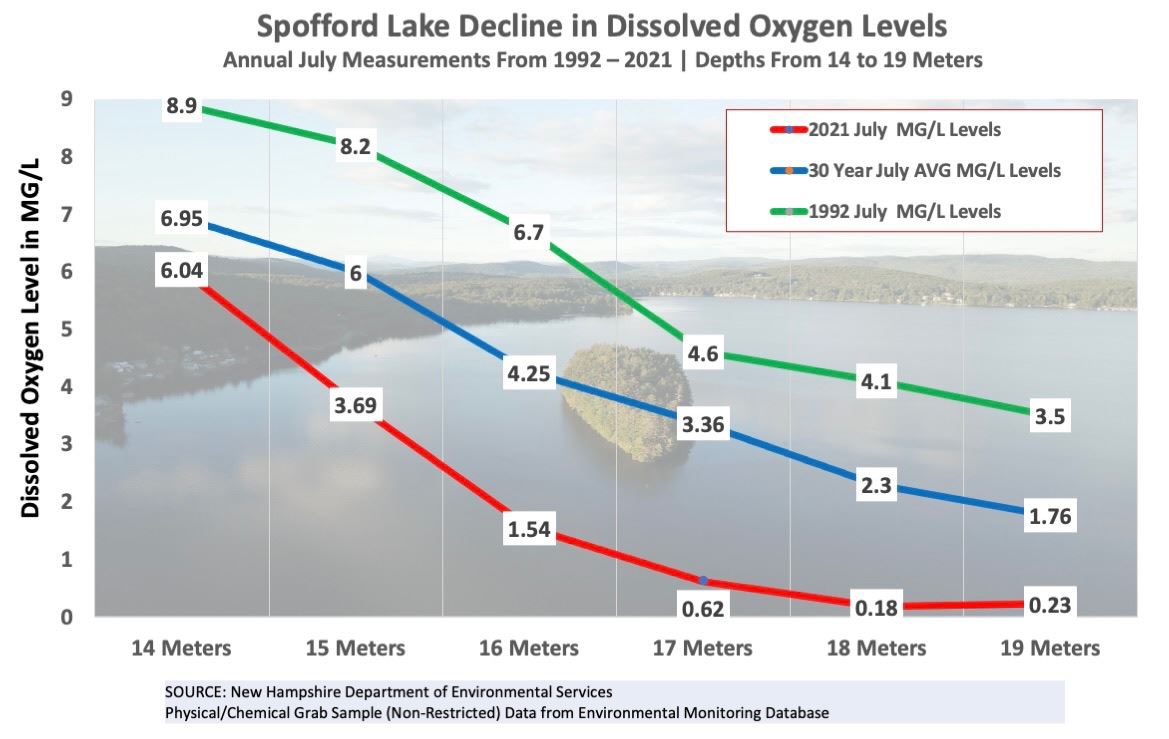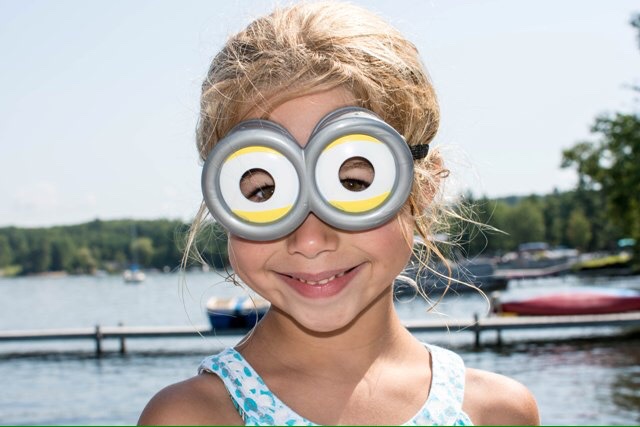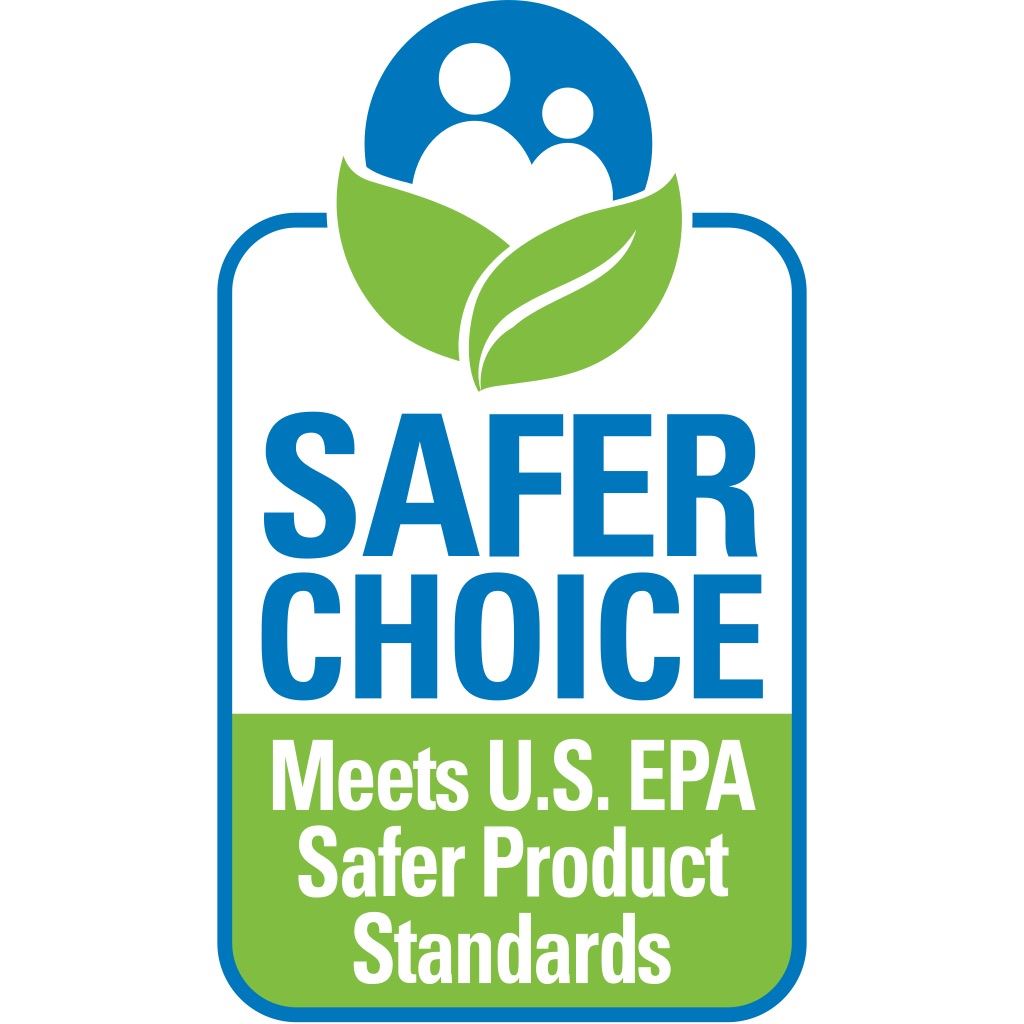Water Quality Monitoring
What is the SLA's Water Quality Monitoring Program (WQMP)? The SLA has had an active and evolving water quality monitoring program for over three decades. Its goal is to achieve a detailed picture of the Lake's physical, chemical, and biological profile. The Water Quality Monitoring team, in conjunction with NH DES' Volunteer Lake Assessment Program (VLAP) collects water samples between May and September sending them to the State's limnology labs for analysis. Spring and Fall turnover samplings are also collected. The results form the basis of the VLAP Annual Report, the most recent of which is available in the sidebar. What is being measured and where? Both the 2023 and 2024 Water Quality Monitoring Program (WQMP), one of the most robust in the state, collected (per year) roughly 600 samples from 20 stations. These stations include selected tributaries draining into Spofford (both in the watershed and at the shoreline), the outlet/dam, all 7 beaches, the boat launch, and the deep spot. Conditions permitting, 14 water quality parameters are sampled at each of the 4 regular sampling events (May, July, August and September). Other measurements are taken at Spring and Fall turnover. The parameters are: dissolved oxygen and water temperature by meter, color, chloride, E. coli bacteria, pH, alkalinity (acid buffering capacity), total phosphorous, water clarity (via Secchi disk), conductivity, and turbidity, total nitrogen, organic carbon, and phytoplankton. What are the 2024 WQMP Results & Trends? (To help understand the science, use our Glossary of Lake Terms.) Through the lens of NH Water Quality VLAP Test Results: The results are generally consistent with prior years, but there are some increasingly worrying trends in the areas of conductivity, chloride levels, transparency and Total Phosphorous (TP). (See VLAP figure 6.) E.coli and Bacteria: On balance, E. coli results were good. Bacteria levels at the beaches and the boat ramp were well below NH State standards with one exception in May. Except for a couple of readings in July, E. coli levels in the tributaries were below state standards for surface water. Average Chlorophyl-A: A measure of algal growth, Spofford’s were less than the state median; water clarity was generally good; and pH levels were in the desirable range. Conductivity and Chloride: These were worrisome. Both were higher than the state median levels. Historical trends indicate significantly worsening conductivity levels since monitoring began. Chloride levels were generally in the Good range for most sampling results in 2023 and 2024, but the 2024 levels were somewhat elevated overall. For conductivity, levels continue to be Excessive for most sampling events in 2024 and comparable to levels recorded in 2023. Typical contributors to conductivity and chloride levels are road salt, faulty septic systems, and water softeners. Total Phosphorus: Elevated TP has been consistently detected at several tributary sampling stations, and at the deep spot. The level of TP, the most important parameter affecting long-term health, is a particular concern. Levels for 2024 were elevated compared to 2023 at both the deep spot and at tributary stations. For May, July, August and September, there were 21 Excessive readings out of 48 total results (46%) at the tributary stations compared to only 12 Excessive readings out of 75 total results (16%) in 2023. Note that the year-to-year results are likely skewed by the very limited number of samples (insufficient water) taken in August and September of 2024. Total phosphorous is a “limiting element” for plant and algal growth. Excessive TP can lead to harmful algae blooms such as cyanobacteria and accelerated plant growth which, in turn, consumes dissolved oxygen in the Lake thereby directly stressing the ability of important fish species to survive. The 2018 Spofford Lake Watershed Management Plan (WMP), prepared by FB Environmental, contained a Lake Loading Response Model (LLRM). The LLRM determines the major sources of phosphorous in the Lake and predicts future loads under various development scenarios. The 2018 LLRM report qualified the findings due to limited sampling data. The SLA, supported by the Town, has since funded a significantly more robust Water Quality Management Program (WQMP) to collect additional data. With this new and additional data (2014-2023), the LLRM was updated in 2023 to create a “LLRM 2.0.” The results show a significant increase in the estimated internal TP loading. Specifically, the LLRM 2.0 estimated three-fold increase in internal phosphorous loading from 14 kg/yr (6%) in 2017 to 42 kg/yr (~19%). LLRM 2.0 now estimates that watershed runoff combined with baseflow contributes 46% of the TP load to the Lake, followed by atmospheric deposition (20%), internal loading (19%), septic system (12%), and waterfowl (3%). Why is Internal Loading Important? Here’s a quick primer on the process of internal phosphorus loading and its impacts on Spofford Lake:
Dissolved Oxygen: It is concerning that levels generally declined at the deep spot. Of the 80 readings taken at various depths over the four sampling events, DO was lower at 52 of the sampling points. Notably, the depth at which the anoxic zone (<2 mg/L) was defined at the bottom of the deep spot from 2023 to 2024 went from 19M to 16M in July; and from 16M to 15M in August. Interestingly, the DO levels in September 2024 were generally comparable to the DO levels in September 2023. Were there any Additions to the 2024 WQMP? In 2024, in addition to the regular sampling and testing program, a Continuous Monitoring Buoy (CMB) was installed at the deep spot in August to track temperature and oxygen. The CMB, submerged to not interfere with boating activities, takes constant readings of temperature and dissolved oxygen. This data will provide a better understanding of the changes in the amount of dissolved oxygen at different depths over time. The SLA, the Town, and the Conservation Commission all contributed to fund the cost of purchasing and deploying the CMB. What about the 2025 WQMP? Anything New? Recent data suggests that increasing internal phosphorous loading at the deep spot. And there is concern that other areas of the Lake might also be experiencing anoxia. Thus, FB Environmental has recommended an addition to our existing program, sediment coring. (The SLA undertook an initial core sediment sampling project in 2020). The internal phosphorus load, i.e., phosphorus coming out of the sediments when oxygen gets low late in summer, was higher than originally estimated based on more limited 2020 data. The 2025 sediment samplings (aka sediment coring 2.0) are planned at a variety of depths around the Lake and at along two primary flow transects across the Lake. These new samples, collected both within and outside of the current low oxygen area of the Lake, will allow a more detailed insight into the extent and location of any new low oxygen areas. Exact dates for this new sediment sampling have not yet been fixed, but is planned for August. We anticipate the results by late October. To add yet another layer, the SLA has reached out to DES to ask if it could use the bathymetric survey data collected in October 2022 to plot out the changes in the areal extent of the anoxic layer over the past several years. We await a response. Why Take These All Measurements? Over the past few years, we have built up a strong base of information on Spofford’s water quality. Increasingly, it would seem as if Spofford has a serious internal phosphorous loading problem. But there are some gaps in our data. With more and more precise data, better decisions can be made as to what future steps, if any, might be taken to address to the problem. What can I as a homeowner do to help? Take time to understand the Lake's vulnerabilities and take steps to maintain and improve Spofford Lake's water quality. Be aware that the SLA-funded Watershed Management Plan and the SLA-funded Core Sediment Analysis provide greater context to the VLAP reports. Implement practices to minimize runoff from your property, for example:
Page updated April 28, 2025 |







